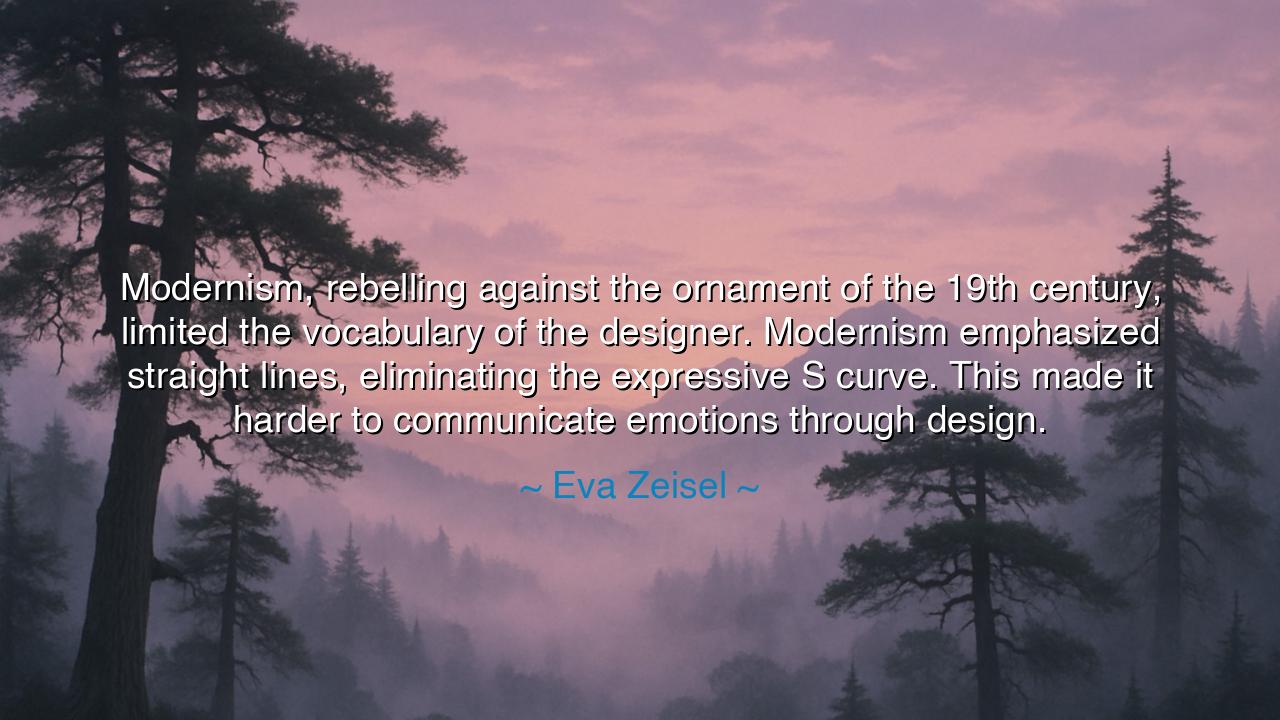
Modernism, rebelling against the ornament of the 19th century
Modernism, rebelling against the ornament of the 19th century, limited the vocabulary of the designer. Modernism emphasized straight lines, eliminating the expressive S curve. This made it harder to communicate emotions through design.






“Modernism, rebelling against the ornament of the 19th century, limited the vocabulary of the designer. Modernism emphasized straight lines, eliminating the expressive S curve. This made it harder to communicate emotions through design.” Thus spoke Eva Zeisel, a master of form and feeling, who saw in design not merely structure but soul. In her words lies both a critique and a lament—a recognition that in the quest for purity and progress, something human was lost. She speaks of Modernism, the great movement that rose in the 20th century to sweep away the excesses of the past, and of the price it exacted upon the language of beauty. Her tone is not of rejection but of mourning, as one might grieve for a language forgotten, a melody silenced.
In the 19th century, design was adorned with ornament—with curves, flourishes, and gestures that spoke directly to the senses. Buildings, furniture, and everyday objects bore the marks of human touch, the embellishments of pride and passion. But when Modernism arose, it came like a cleansing wind, stripping away what it deemed unnecessary, favoring instead the straight line, the right angle, the cold perfection of function. The machine became both tool and idol, and ornament—once the language of emotion—was exiled. To many, this was liberation: a triumph of clarity, reason, and efficiency. Yet to Zeisel, who saw beauty as a form of love, it was also a narrowing of expression, a shrinking of the designer’s emotional vocabulary.
For what is design, she asks, if not a dialogue between creator and beholder? The S curve, that sinuous, living line, speaks a language older than words. It is the curve of the river, the petal, the human body itself. It whispers of softness, of grace, of the continuity between nature and art. To eliminate the curve is to cut off design from the organic rhythm of life—to render it cold, geometric, and unfeeling. Zeisel, whose own works overflow with gentle curves and interlocking forms, sought to restore tenderness to design, to bring back the sense that an object might hold within it a pulse, a breath, a human presence.
History offers many reflections of this struggle between purity and passion. Consider the architecture of Le Corbusier, whose white boxes and clean planes defined the modern city. His work was revolutionary, a hymn to the efficiency of the machine age—but it also left many souls cold. Contrast this with the curves of Antoni Gaudí, the Spanish architect whose Sagrada Família rises like a living thing, its columns bending like trees in prayer. Gaudí’s lines, like Zeisel’s, flow with emotion, with empathy for the organic and the sacred. Between these two visions lies the great tension of design: the pull between reason and feeling, order and life. Zeisel, standing at this crossroads, chose the side of warmth—the side of human expression.
Her rebellion against Modernism was not an act of destruction, but of restoration. She did not despise its ideals; she sought to heal its imbalance. For she understood that function and feeling need not be enemies—they are, in truth, partners. A chair can be practical and still embrace the body with kindness. A teacup can serve its purpose and still caress the hand that holds it. The curve, she taught, is not decoration—it is communication. Through it, the designer speaks to the user in a universal language of comfort, intimacy, and care. To deny that language is to deny the full range of what it means to be human.
Zeisel’s own creations bear this truth. Her ceramics curve like smiles, her vases seem to breathe, her dinnerware rests against itself like lovers in quiet conversation. She once said that every object should express “the playful search for beauty”, and indeed, her forms carry that playfulness—the joy of the human spirit made tangible. Against the rigidity of Modernism, she offered gentleness; against its austerity, she offered emotion. Her designs were not only to be used, but to be felt, to remind the user that beauty and utility can coexist in harmony, as nature itself has always shown us.
So, my listener, take this teaching into your own craft and life. Do not worship the straight line alone; do not mistake simplicity for soul. The world needs the curve, the gentle imperfection that breathes life into all things. In whatever you create—whether art, relationship, or dream—let it carry a touch of softness, a hint of grace. Remember that emotion is not weakness but meaning, that to move another heart is the highest achievement of design.
Thus, remember the wisdom of Eva Zeisel: that true design, like true living, must balance reason with tenderness, order with warmth. The straight line may build a house, but it is the curve that makes it a home. Let your work, like hers, speak not only to the eye but to the heart, for it is through feeling that form becomes alive, and through beauty that the soul endures.






AAdministratorAdministrator
Welcome, honored guests. Please leave a comment, we will respond soon